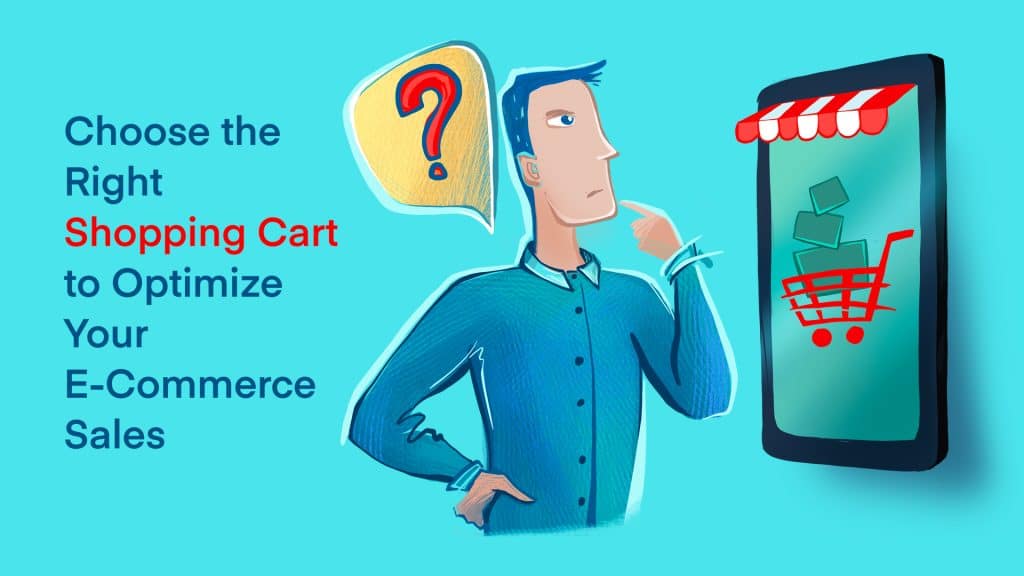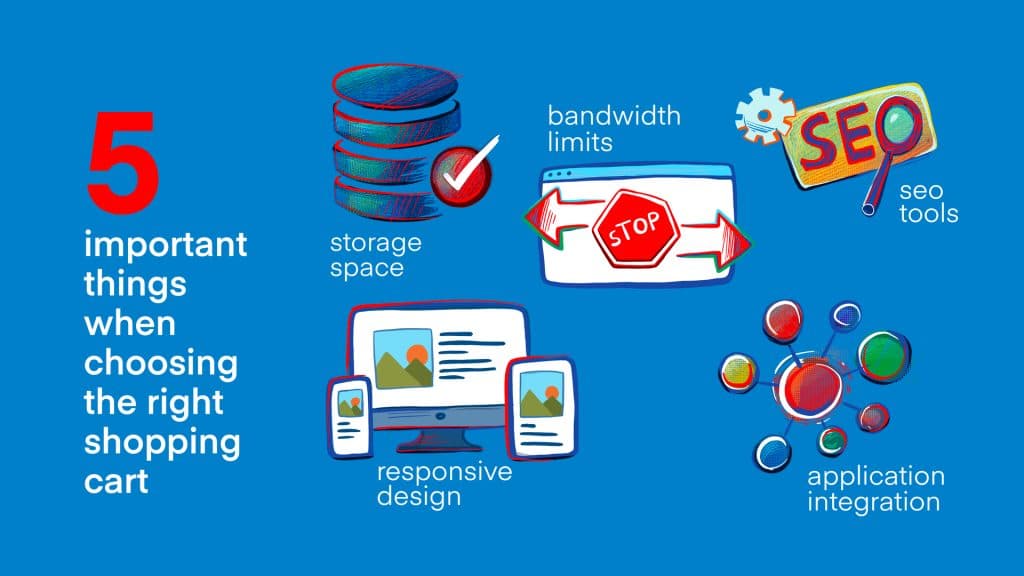
For an ecommerce business to transition from third-party to first-party sales, it needs a safe, convenient, and reliable way to share a virtual catalog of its products and process customer payments. One of the main allures of third-party marketplaces is that they take these responsibilities off your plate.
As a result, it is easy for sellers to become comfortable with their third-party status and, therefore, reluctant to leave the comfort of their marketplace channels. This is where shopping cart platforms come in. Shopping carts are software solutions that support several key ecommerce features vital to successful first-party sales.
Shopping carts provide options for storing, organizing, and categorizing product information for customers to interact with. Once a user is prepared to purchase, shopping carts securely accept and remit their payments. They then distribute relevant logistical information to both the seller and the customer so that the transaction can be completed smoothly.
Descartes Sellercloud integrates with many industry-leading shopping carts to help you conduct first-party transactions with confidence. That said, not all shopping cart platforms are created equal. Different options are available, and their fit with your ecommerce business will depend on your products, your first-party web presence, and your general tech comfort level.
If you aren’t careful, you may be investing time and money into the wrong shopping cart for your needs, missing out on lucrative first-party sales (especially in the current ecommerce climate). Here are several features to consider before settling on the right shopping cart platform for your ecommerce business.
Hosted Versus Self-Hosted Shopping Carts
One of the major distinctions between shopping cart platforms is whether they host your catalog and transactional data on their own servers or if you need to provide your own server. Hosted shopping carts typically provide features and plug-and-play convenience that should be familiar to third-party sellers.
Your shopping cart provider stores and supports your catalog (including images, descriptions, customer reviews, Q&As, etc.). You don’t need to know how to code or design a storefront.
You can become a first-party seller by entering your merchandise, payment, and shipping details. Self-hosted shopping carts (sometimes referred to as seller-managed, licensed, or open-source shopping carts) can be a bit more complicated to set up and maintain than a hosted shopping cart. As the name implies, you are in charge of purchasing or leasing server space where your store’s data will live.
This adds an additional cost to consider and requires some technical know-how to get everything running (and keeping it running) smoothly. The reward for this added layer of responsibility is a higher degree of customization for your storefront and its backend.
Many seller-hosted shopping cart providers do include useful interfaces that make it fairly straightforward to add your product catalog and relevant business credentials. However, others either require or allow the use of additional third-party plugins or add-ons to set up your ecommerce shopping cart exactly as you like it.
Sometimes, these plug-ins are free, but they often come at an added expense. Regardless, some general web design and coding savvy is often required to get the most bang for your buck when managing your shopping cart hosting.
Designed well, a self-hosted shopping cart can create a unique and tailored online shopping experience for your customers that stands out from the common templated appearances of most hosted shopping cart options. It delivers exactly the features you need with minimal bloat. If this seems too overwhelming, hosted shopping carts remain strong and reliable options as well.
Technical Specifications That Matter
Regardless of which type of ecommerce shopping cart platform you choose to enlist, there are some essential technical details you need to pay attention to. Many shopping carts operate different subscription tiers, which offer a range of both cost-effective and high-performance options to choose from.
These tiered subscription models typically differ based on the following criteria:
Storage Space
Whether it is the space allotted to you by a hosted shopping cart provider or the space you need to acquire to host your shopping cart on your own, you must be sure you have enough. Every product, image, and video consumes valuable bytes. In some cases, email storage also counts against your storage cap—something to consider if email marketing, shipment tracking, and customer service will be handled through your shopping cart platform.
Bandwidth Limits
You could have unlimited storage, but if you and/or your customers can’t access the information they need when they need it, it doesn’t mean much.
Most shopping cart providers and third-party server partners impose bandwidth restrictions on how much data can be transferred to and from your shopping cart (typically calculated monthly). The more customers you have, the more multimedia you include in your catalog, and the more edits you plan to make to your listings, the more bandwidth you will need.
In some cases, service providers will offer unlimited bandwidth. Be sure to check the fine print to see if there is a catch. Often, unlimited bandwidth offers come with speed restrictions (which can grind the process of browsing and searching your catalog to a halt) or limitations on the size of your catalog.
SEO Tools
A big part of selling online is ensuring customers can find your products. Unlike third-party marketplaces where customers arrive and search on an established retail gateway, your first-party store relies on either customers seeking out your web address directly or using a search engine.
Knowing this, many shopping carts are built with search engine optimization (SEO) features that help boost the odds that search engines will match their users to your products. Sometimes, these SEO features are baked in in ways you aren’t expecting. For instance, shopping carts that allow you to add and organize categories and keywords within your catalog will make store navigation more intuitive for customers and simpler for search engines to crawl and index.

Appearance and Responsive Design
Technical specs matter, but so does appearance. Before settling on a shopping cart partner, evaluate whether the available aesthetic options and templates are a good fit for your brand and your customers. The most efficient site design in the world may still lead to abandoned carts if customers don’t feel engaged with your interface.
Similarly, the most beautiful website in the world can still lose sales by forcing customers to click through numerous hoops and pages before finally checking out. Therefore, you must choose a design that draws your customers in, makes finding products simple, and gets customers from the cart to the checkout quickly.
Also, consider how your customers engage with the web. Pay attention to how your catalog will appear on various devices, such as smartphones, tablets, computers, and television screens. The best websites and hosts know to take this scalability—commonly advertised as responsive design—into account and provide options to automate page layouts accordingly.
Application Integrations
Diversifying your ecommerce presence is crucial to scaling your business. Listing on multiple channels is a key way to maximize your product and brand exposure, and shopping carts can help you do this.
Some shopping carts offer integrations with third-party marketplaces, which allow you to share your catalog directly with sites like Amazon and eBay. Other shopping carts require external plug-ins to make everything mesh correctly. In either case, you are responsible for maintaining listings so they are compliant with the marketplace channel’s terms of service.
You also have to have a plan to track your inventory levels. Spreading an entire catalog’s worth of listings across multiple channels can be a recipe for disaster without a plan to track and update inventory data in real-time. Thankfully, most shopping carts have other application integrations beyond just marketplace channels.
The Descartes Sellercloud omnichannel ecommerce platform integrates with many popular and reliable shopping cart providers. With it, you can manage your entire product catalog from one convenient location while also ensuring compliance across all channels where you sell.
Perhaps even more valuable, Descartes Sellercloud features a robust, industry-leading inventory management platform that not only tracks where every piece of your inventory is but also uses cloud-based technology to keep your inventory levels up-to-date across all channels where you sell.
What’s more, predictive purchasing alerts let you know when it’s time to restock. This makes life especially easy for ecommerce retailers looking to maintain both a first- and third-party selling presence. No more overselling products or out-of-stock listings.
For more on how Descartes Sellercloud’s shopping cart integrations can help increase your business’s visibility, convenience, and productivity, contact us directly for a free demo.




